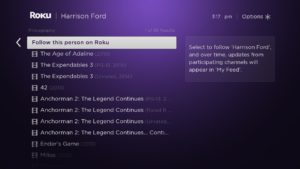Is Universal Search Part of Your OTT Marketing Strategy?
August 30, 2018
If not, now is the time!
For organizations launching OTT services in 2018, TV app discovery has never been more critical. With hundreds of brands deploying multiple TV apps across connected TVs, streaming media devices, and mobile devices, how can companies compete for viewers in an increasingly crowded space? Perhaps more importantly, as consumers, how can we find what we’re looking for without having to scour hundreds of TV apps?
Outside of traditional marketing, i.e., social media, PPC, cross-promotion, etc.. there are the marketing agreements with the manufacturers. For example, publishers could participate in marketing services with Roku to be published in the “Featured” section or could advertise directly on the Roku home menu. These ads would “deep link” into specific content available in the brand’s library. If users didn’t have the apps installed, it would initiate the process for them. Apple and Amazon offer similar services as well. The problem here is that there is a relatively high cost for these services which could be a barrier to entry.
One of the best alternatives, but something that’s a bit under the radar, is “Universal Search.” Each of the manufacturers has a different name for this, but the function is the same. Using text or voice, users can search for a movie, TV series, or series episode, on the device and it will parse through an entire catalog looking for it. Searches can also be performed on actors and directors. Once found, the search will return a set of services that contain that piece of content. Users then have the option to install that app and watch – this is how unknown services with great content can drastically increase their installs.
For brevity’s sake, we’re going to limit the discussion to the three primary streaming devices available to consumers in the U.S. – Roku, Apple TV, and Amazon Fire TV.

Roku Universal Search
Take Roku for example. A user can be on the home screen, and on the left menu can select the search function. Users can search for movies, TV series, and episodes and if the content exists on the platform and has been cataloged, it will appear in the search results. Or, let’s say a user is already inside of another app and can’t find what they’re looking for. Using the voice search button, they can say the name of the movie, show, or episode, and it will locate and display the results without any additional navigation required. Text and voice search perform similarly on Apple TV, and Amazon Fire TV as well.
How does this work?
Each platform has different requirements to integrate a library of content into their searchable database. But the primary way is to prepare a formatted list (XML), with the searchable library and make it available to the platform. This would be a single file that would be stored in a location that’s made accessible by the platform’s search function. Several times a day the platform will ingest a fresh version of the file to ensure that the library has the most current list of the brand’s content.
Once integrated into the search system, the results can be dramatic. It’s the sure fire way to increase installs by having users stumble into content that may exist in the brand’s library. Universal Search can be incorporated relatively easy by companies that support it. While each OEM (Roku, Amazon, Apple) has their own specific requirements to implement Universal Search, it’s not overly challenging to integrate once approved.
Here are some of the necessary requirements based on platform:
Roku (Universal Search)
1. Open eligibility and available to all partners with appropriate content.
2. Is limited to Movies, and TV Shows. Roku doesn’t support short-form clips.
3. The system is open with a relatively simple process to get integrated.
4. Supports text-based and voice searching
Amazon Fire TV (Catalog Integration)
1. Open eligibility, although not every service qualifies
2. Must make at least 90% of the content library available
3. All content must be able to be referenced on IMDB or the Amazon library
4. Supports text-based, voice searching, and can be integrated into Alexa
Apple TV (Universal Search)
1. Invitation only
2. Requires significant application updates on both mobile and TV platforms.
3. Complex technical integration – involves app code updates on both iOS and TVOS.
4. Supports text-based, voice searching, and requires Siri integration.
Once implemented, the benefits have been significant. Some services have reported a 30-40% increase in app installs. Publishers can expect a ~20% increase in app discovery / installs once rolled out. This number could be higher on Fire TV with Alexa integration!
Universal Search is a sure-fire way to get traction quicker on these platforms. With the cost of setup and integration reasonably low, this would seem to be a no-brainer part of any service’s marketing strategy.
Make sure to ask your vendors if they support universal search on these platforms.